Projekte përkthimi
Translation organization
Weblate organizes translatable VCS content of project/components into a tree-like structure.
The bottom level object is Project configuration, which should hold all translations belonging together (for example translation of an application in several versions and/or accompanying documentation).
On the level above, Component configuration, which is actually the component to translate, you define the VCS repository to use, and the mask of files to translate.
Above Component configuration there are individual translations, handled automatically by Weblate as translation files (which match Maskë kartele defined in Component configuration) appear in the VCS repository.
Weblate supports a wide range of translation formats (both bilingual and monolingual ones) supported by Translate Toolkit, see Formate të mbuluar kartelash.
Shënim
You can share cloned VCS repositories using URL të brendshme Weblate. Using this feature is highly recommended when you have many components sharing the same VCS. It improves performance and decreases required disk space.
Adding translation projects and components
Ndryshuar në versionin 3.2: An interface for adding projects and components is included, and you no longer have to use Ndërfaqe përgjegjësi Django.
Ndryshuar në versionin 3.4: The process of adding components is now multi staged, with automated discovery of most parameters.
Based on your permissions, new translation projects and components can be created. It is always permitted for users with the Add new projects permission, and if your instance uses billing (e.g. like https://hosted.weblate.org/ see Faturim), you can also create those based on your plans allowance from the user account that manages billing.
You can view your current billing plan on a separate page:
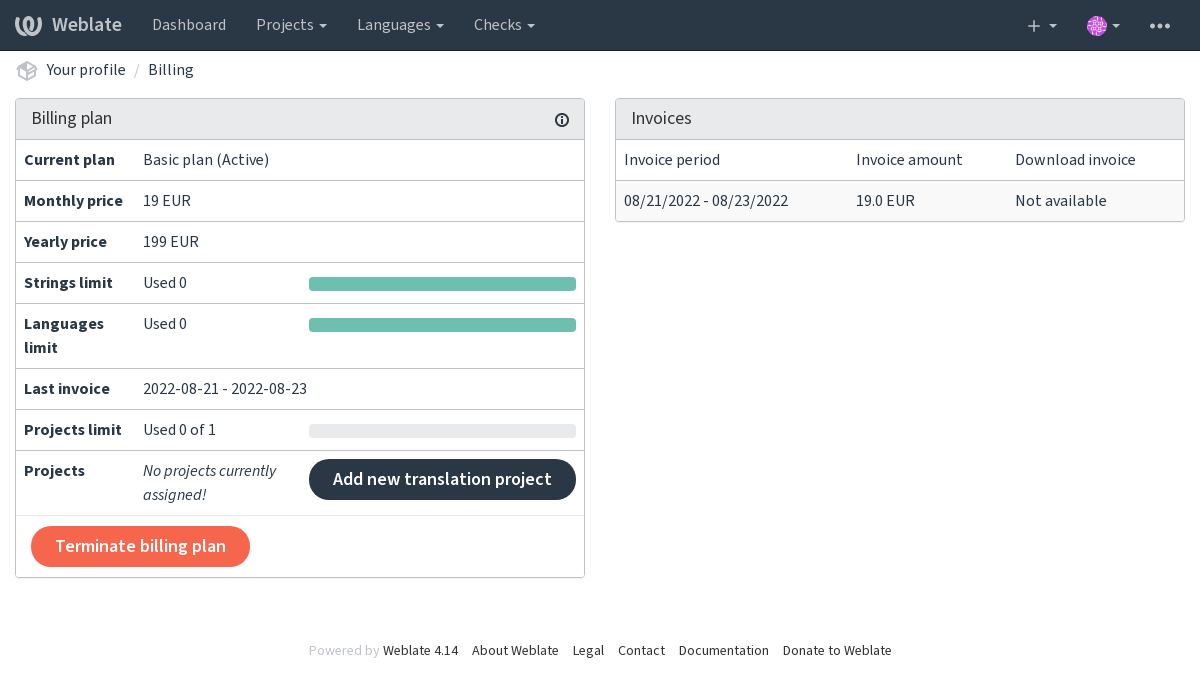
The project creation can be initiated from there, or using the menu in the navigation bar, filling in basic info about the translation project to complete addition of it:
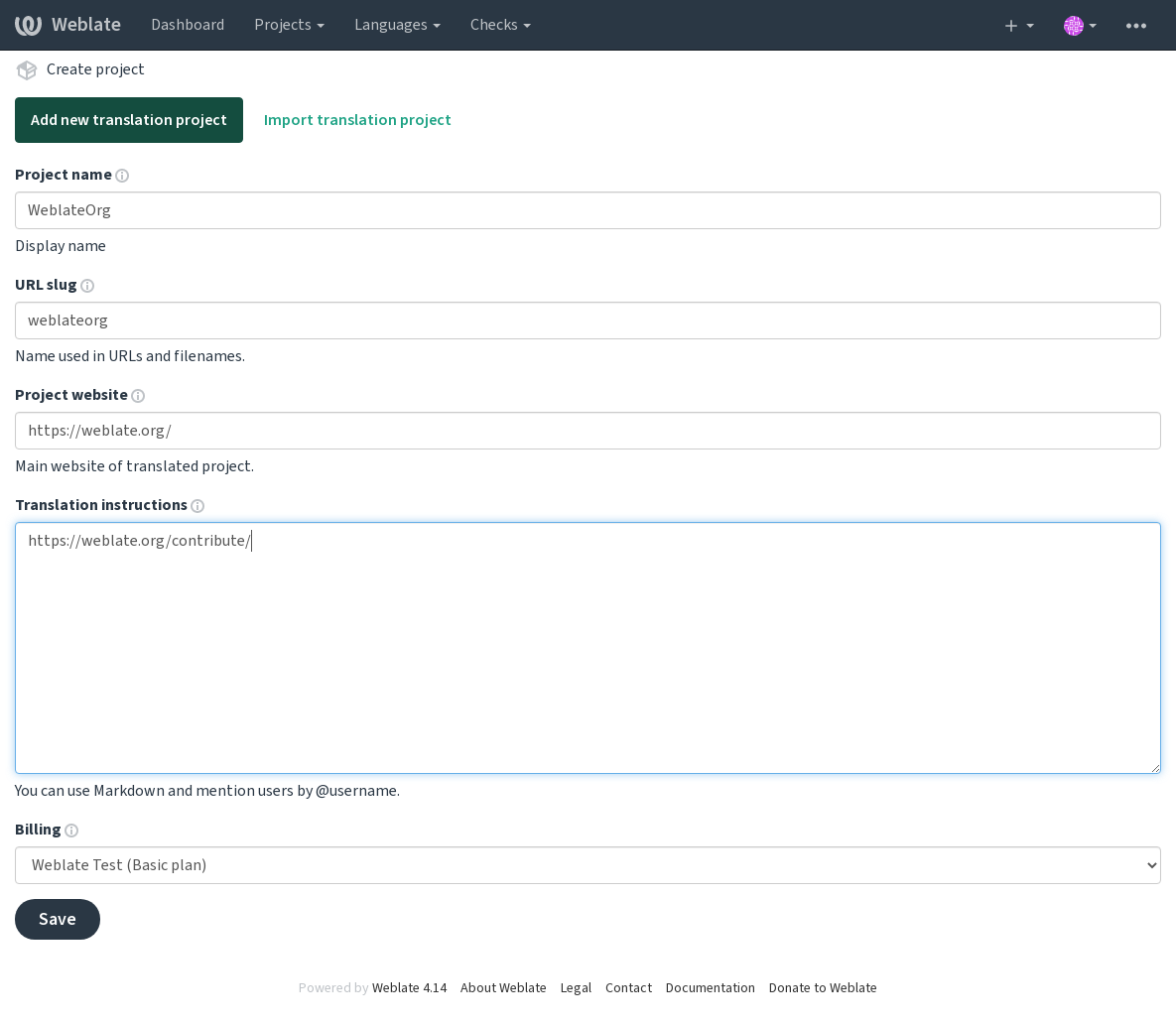
After creating the project, you are taken directly to the project page:

Creating a new translation component can be initiated via a single click there. The process of creating a component is multi-staged and automatically detects most translation parameters. There are several approaches to creating component:
- Prej kontrolli versionesh
Creates component from remote version control repository.
- Prej përbërësi ekzistues
Creates additional component to existing one by choosing different files.
- Degë shtesë
Creates additional component to existing one, just for different branch.
- Ngarkoni kartela përkthimesh
Upload translation files to Weblate in case you do not have version control or do not want to integrate it with Weblate. You can later update the content using the web interface or Weblate’s REST API.
- Përktheni dokument
Upload single document or translation file and translate that.
- Nisjani nga hiçi
Create blank translation project and add strings manually.
Once you have existing translation components, you can also easily add new ones for additional files or branches using same repository.
First you need to fill in name and repository location:
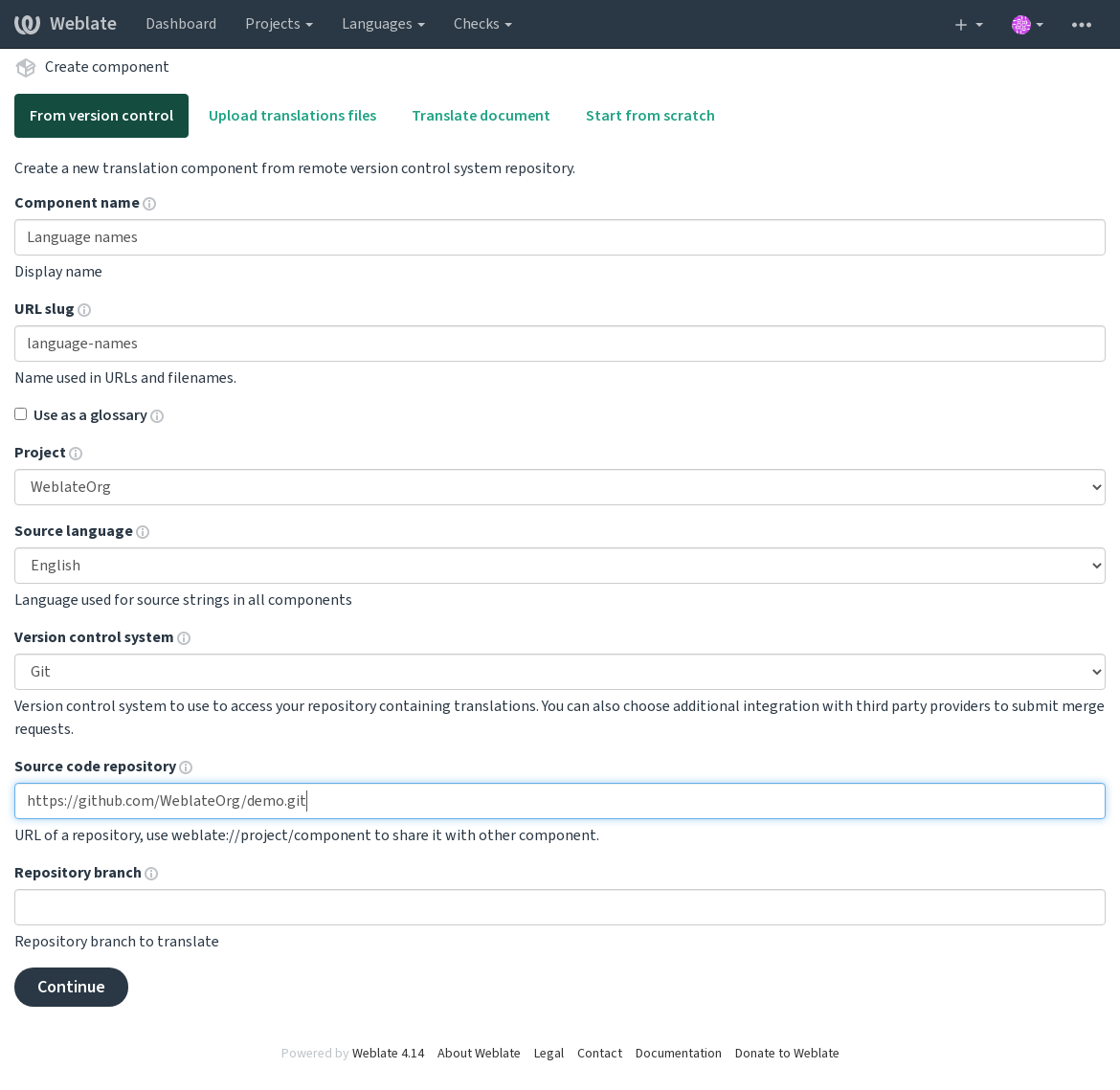
On the next page, you are presented with a list of discovered translatable resources:
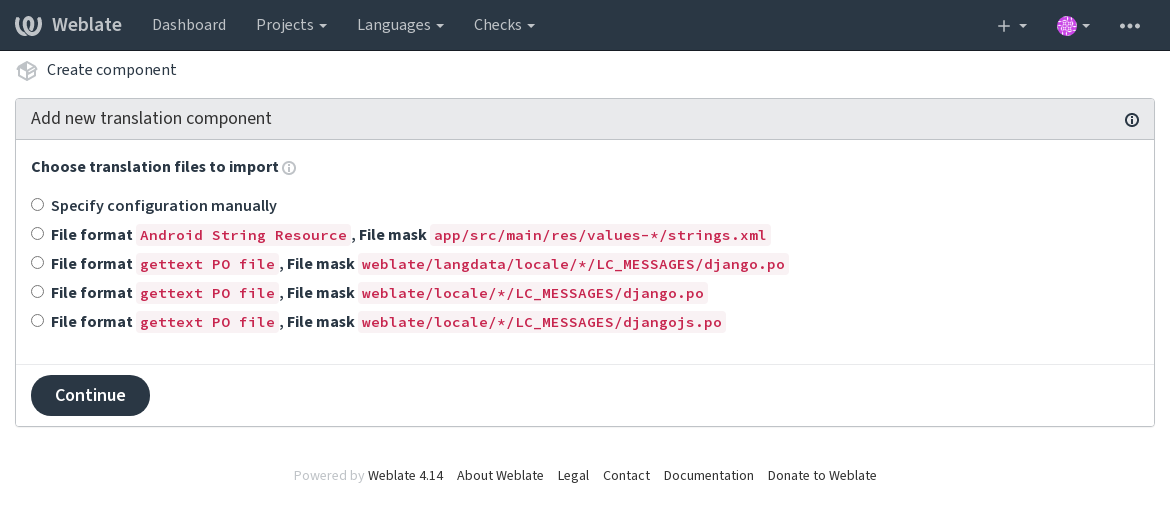
As a last step, you review the translation component info and fill in optional details:
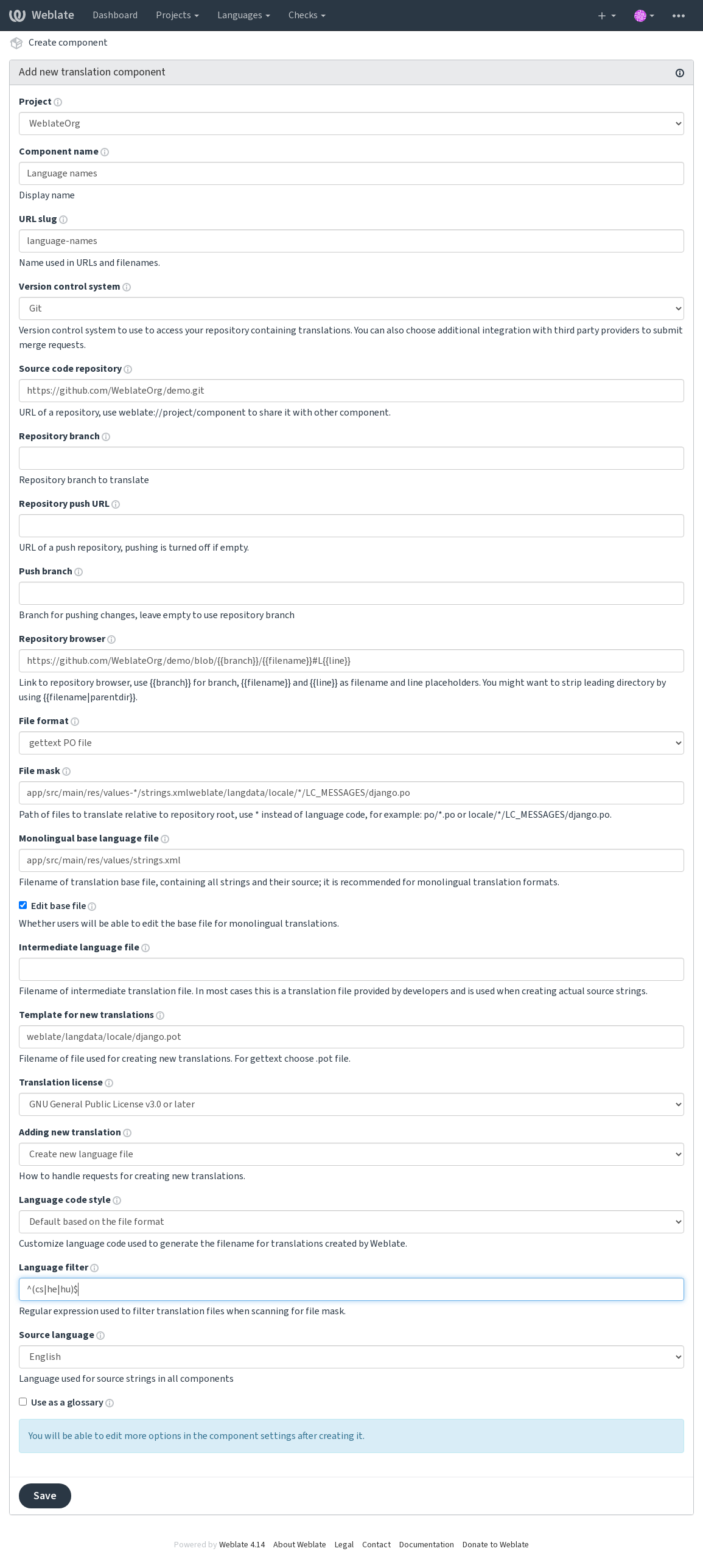
Project configuration
Create a translation project and then add a new component for translation in it. The project is like a shelf, in which real translations are stacked. All components in the same project share suggestions and their dictionary; the translations are also automatically propagated through all components in a single project (unless turned off in the component configuration), see Kujtesë Përkthimesh.
Shihni edhe
These basic attributes set up and inform translators of a project:
Emër projekti
Verbose project name, used to display the project name.
Identifikues URL-je
Project name suitable for URLs.
Sajt projekti
URL where translators can find more info about the project.
This is a required parameter unless turned off by WEBSITE_REQUIRED.
Udhëzime përkthimi
Text describing localization process in the project, and any other information useful for translators. Markdown can be used for text formatting or inserting links.
Caktoni krye «Language-Team»
Whether Weblate should manage the Language-Team header (this is a
GNU gettext only feature right now).
Kontroll hyrjesh
Configure per project access control, see Kontroll hyrjesh te projekti for more details.
The default value can be changed by DEFAULT_ACCESS_CONTROL.
Aktivizoni shqyrtime
Enable review workflow for translations, see Shqyrtues enkas.
Aktivizo shqyrtime burimi
Enable review workflow for source strings, see Shqyrtim vargjesh burim.
Shihni edhe
Aktivizoni hook-e
Whether unauthenticated Hook-e njoftimesh are to be used for this repository.
Aliase gjuhe
Define language codes mapping when importing translations into Weblate. Use this when language codes are inconsistent in your repositories and you want to get a consistent view in Weblate or in case you want to use non-standard naming of your translation files.
The typical use case might be mapping American English to English: en_US:en
Multiple mappings to be separated by comma: en_GB:en,en_US:en
Using non standard code: ia_FOO:ia
Ndihmëz
The language codes are mapped when matching the translation files and the matches are case sensitive, so make sure you use the source language codes in same form as used in the filenames.
Shihni edhe
Component configuration
A component is a grouping of something for translation. You enter a VCS repository location and file mask for which files you want translated, and Weblate automatically fetches from this VCS, and finds all matching translatable files.
Shihni edhe
You can find some examples of typical configurations in the Formate të mbuluar kartelash.
Shënim
It is recommended to keep translation components to a reasonable size - split the translation by anything that makes sense in your case (individual apps or add-ons, book chapters or websites).
Weblate easily handles translations with 10000s of strings, but it is harder to split work and coordinate among translators with such large translation components.
Should the language definition for a translation be missing, an empty definition is created and named as «cs_CZ (generated)». You should adjust the definition and report this back to the Weblate authors, so that the missing languages can be included in next release.
The component contains all important parameters for working with the VCS, and for getting translations out of it:
Emër përbërësi
Verbose component name, used to display the component name.
Component slug
Component name suitable for URLs.
Component project
Project configuration where the component belongs.
Sistem kontrolli versionesh
VCS to use, see Integrim kontrolli versioni for details.
Shihni edhe
Depo kodi burim
VCS repository used to pull changes.
Shihni edhe
See Hyrje në depo for more details on specifying URLs.
Ndihmëz
This can either be a real VCS URL or weblate://project/component
indicating that the repository should be shared with another component.
See URL të brendshme Weblate for more details.
URl push për depon
Repository URL used for pushing. This setting is used only for Git and Mercurial and push support is turned off for these when this is empty.
For linked repositories, this is not used and setting from linked component applies.
Shihni edhe
See Hyrje në depo for more details on how to specify a repository URL and Pushing changes from Weblate for more details on pushing changes from Weblate.
Shfletues depoje
URL of repository browser used to display source files (location of used messages). When empty, no such links will be generated. You can use Template markup.
For example on GitHub, use something like:
https://github.com/WeblateOrg/hello/blob/{{branch}}/{{filename}}#L{{line}}
In case your paths are relative to different folder (path contains ..), you
might want to strip leading directory by parentdir filter (see
Template markup):
https://github.com/WeblateOrg/hello/blob/{{branch}}/{{filename|parentdir}}#L{{line}}
URL depoje të eksportuar
URL where changes made by Weblate are exported. This is important when Përkthim në vazhdimësi is not used, or when there is a need to manually merge changes. You can use Git exporter to automate this for Git repositories.
Degë depoje
Which branch to checkout from the VCS, and where to look for translations.
For linked repositories, this is not used and setting from linked component applies.
Degë push
Branch for pushing changes, leave empty to use Degë depoje.
For linked repositories, this is not used and setting from linked component applies.
Shënim
This is currently only supported for Git, GitLab and GitHub, it is ignored for other VCS integrations.
Shihni edhe
Maskë kartele
Mask of files to translate, including path. It should include one «*» replacing language code (see Language definitions for info on how this is processed). In case your repository contains more than one translation file (e.g. more gettext domains), you need to create a component for each of them.
For example po/*.po or locale/*/LC_MESSAGES/django.po.
In case your filename contains special characters such as [, ], these need
to be escaped as [[] or []].
Kartelë njëgjuhëshe gjuhe bazë
Base file containing string definitions for Përbërës njëgjuhësh.
Përpunoni kartelën bazë
Whether to allow editing the base file for Përbërës njëgjuhësh.
Kartelë gjuhe ndërmjetëse
Intermediate language file for Përbërës njëgjuhësh. In most cases this is a translation file provided by developers and is used when creating actual source strings.
When set, the source strings are based on this file, but all other languages are based on Kartelë njëgjuhëshe gjuhe bazë. In case the string is not translated into the source language, translating to other languages is prohibited. This provides Quality gateway for the source strings.
Gjedhe për përkthime të reja
Base file used to generate new translations, e.g. .pot file with gettext.
Ndihmëz
In many monolingual formats Weblate starts with empty file by default. Use this in case you want to have all strings present with empty value when creating new translation.
Format kartelash
Translation file format, see also Formate të mbuluar kartelash.
Adresë njoftimi të metash në vargje burim
Email address used for reporting upstream bugs. This address will also receive notification about any source string comments made in Weblate.
Lejo përhapje përkthimesh
You can turn off propagation of translations to this component from other components within same project. This really depends on what you are translating, sometimes it’s desirable to have make use of a translation more than once.
It’s usually a good idea to turn this off for monolingual translations, unless you are using the same IDs across the whole project.
Default value can be changed by DEFAULT_TRANSLATION_PROPAGATION.
Shihni edhe
Enable suggestions
Whether translation suggestions are accepted for this component.
Votim sugjerimesh
Turns on vote casting for suggestions, see Votim sugjerimesh.
Vetëprano sugjerime
Automatically accept voted suggestions, see Votim sugjerimesh.
Flamurka përkthimi
Customization of quality checks and other Weblate behavior, see Customizing behavior using flags.
Kontrolle me detyrim
List of checks which can not be ignored, see Enforcing checks.
Shënim
Enforcing the check does not automatically enable it, you still should enabled it using Customizing behavior using flags in Flamurka përkthimi or Additional info on source strings.
Licencë përkthimi
License of the translation (does not need to be the same as the source code license).
Marrëveshje kontribuesi
Marrëveshje përdoruesi që duhet miratuar përpara se një përdorues të mund të përkthejë këtë përbërës.
Shtim përkthimi të ri
How to handle requests for creation of new languages. Available options:
- Lidhuni me mirëmbajtësit
User can select desired language and the project maintainers will receive a notification about this. It is up to them to add (or not) the language to the repository.
- Shpjer te URL udhëzimesh përkthimi
User is presented a link to page which describes process of starting new translations. Use this in case more formal process is desired (for example forming a team of people before starting actual translation).
- Krijoni kartelë gjuhe të re
User can select language and Weblate automatically creates the file for it and translation can begin.
- Çaktivizo shtim përkthimesh të reja
There will be no option for user to start new translation.
Ndihmëz
The project admins can add new translations even if it is disabled here when it is possible (either Gjedhe për përkthime të reja or the file format supports starting from an empty file).
Shihni edhe
Administroni vargje
Të reja në versionin 4.5.
Configures whether users in Weblate will be allowed to add new strings and remove existing ones. Adjust this to match your localization workflow - how the new strings are supposed to be introduced.
For bilingual formats, the strings are typically extracted from the source code (for example by using xgettext) and adding new strings in Weblate should be disabled (they would be discarded next time you update the translation files). In Weblate you can manage strings for every translation and it does not enforce the strings in all translations to be consistent.
For monolingual formats, the strings are managed only on source language and are automatically added or removed in the translations. The strings appear in the translation files once they are translated.
Stil kodi gjuhe
Përshtatni kod gjuhe të përdorur për të prodhuar emrin e kartelës për përkthime të krijuar nga Weblate.
Shihni edhe
Shtim përkthimesh të reja, Kod gjuhe, Parsing language codes
Stil përzierjeje
You can configure how updates from the upstream repository are handled. The actual implementation depends on VCS, see Integrim kontrolli versioni.
- Rebase
Rebases Weblate commits on top of upstream repository on update. This provides clean history without extra merge commits.
Rebasing can cause you trouble in case of complicated merges, so carefully consider whether or not you want to enable them.
You might need to enable force pushing by choosing Git me “force push” as Sistem kontrolli versionesh, especially when pushing to a different branch.
- Përzieji
Upstream repository changes are merged into Weblate one. This setting utilizes fast-forward when possible. This is the safest way, but might produce a lot of merge commits.
- Përzieje pa fast-forward
Upstream repository changes are merged into Weblate one with doing a merge commit every time (even when fast-forward would be possible). Every Weblate change will appear as a merge commit in Weblate repository.
Default value can be changed by DEFAULT_MERGE_STYLE.
Commit, add, delete, merge, add-on, and merge request messages
Message used when committing a translation, see Template markup.
Default value can be changed by DEFAULT_ADD_MESSAGE,
DEFAULT_ADDON_MESSAGE, DEFAULT_COMMIT_MESSAGE,
DEFAULT_DELETE_MESSAGE, DEFAULT_MERGE_MESSAGE,
DEFAULT_PULL_MESSAGE.
Push on commit
Whether committed changes should be automatically pushed to the upstream repository. When enabled, the push is initiated once Weblate commits changes to its underlying repository (see Lazy commits). To actually enable pushing Repository push URL has to be configured as well.
Moshë ndryshimesh për depozitim
Sets how old (in hours) changes have to be before they are committed by
background task or the commit_pending management command. All
changes in a component are committed once there is at least one change
older than this period.
Default value can be changed by COMMIT_PENDING_HOURS.
Ndihmëz
There are other situations where pending changes might be committed, see Lazy commits.
Kyçe, në rast gabimesh
Locks the component (and linked components, see URL të brendshme Weblate) upon the first failed push or merge into its upstream repository, or pull from it. This avoids adding another conflicts, which would have to be resolved manually.
The component will be automatically unlocked once there are no repository errors left.
Gjuhë burimi
Language used for source strings. Change this if you are translating from something else than English.
Ndihmëz
In case you are translating bilingual files from English, but want to be able to do fixes in the English translation as well, choose English (Developer) as a source language to avoid conflict between the name of the source language and the existing translation.
For monolingual translations, you can use intermediate translation in this case, see Kartelë gjuhe ndërmjetëse.
Filtër gjuhësh
Regular expression used to filter the translation when scanning for file mask. It can be used to limit the list of languages managed by Weblate.
Shënim
You need to list language codes as they appear in the filename.
Some examples of filtering:
Filter description |
Shprehje e rregullt |
|---|---|
Selected languages only |
|
Exclude languages |
|
Filter two letter codes only |
|
Exclude non language files |
|
Include all files (default) |
|
Shprehje e rregullt variantesh
Regular expression used to determine the variants of a string, see Variante të vargut.
Shënim
Most of the fields can be edited by project owners or administrators, in the Weblate interface.
Përparësi
Përbërësit me përparësi më të lartë u ofrohen të parat përkthyesve.
Restricted access
By default the component is visible to anybody who has access to the project, even if the person can not perform any changes in the component. This makes it easier to keep translation consistency within the project.
Restricting access at a component, or component-list level takes over access permission to a component, regardless of project-level permissions. You will have to grant access to it explicitly. This can be done through granting access to a new user group and putting users in it, or using the default custom or private access control groups.
The default value can be changed in DEFAULT_RESTRICTED_COMPONENT.
Ndihmëz
This applies to project admins as well — please make sure you will not loose access to the component after toggling the status.
Përdore si fjalorth
Të reja në versionin 4.5.
Allows using this component as a glossary. You can configure how it will be listed using Ngjyrë fjalorthi.
The glossary will be accessible in all projects defined by Ndaje te projekte.
It is recommended to enable Administroni vargje on glossaries in order to allow adding new words to them.
Shihni edhe
Ngjyrë fjalorthi
Display color for a glossary used when showing word matches.
Template markup
Weblate uses simple markup language in several places where text rendering is needed. It is based on The Django template language, so it can be quite powerful.
Currently it is used in:
Commit message formatting, see Component configuration
- Several add-ons
There following variables are available in the component templates:
{{ language_code }}Kod gjuhe
{{ language_name }}Emër gjuhe
{{ component_name }}Emër përbërësi
{{ component_slug }}Component slug
{{ project_name }}Emër projekti
{{ project_slug }}Project slug
{{ url }}Translation URL
{{ filename }}Emër kartele përkthimi
{{ stats }}Translation stats, this has further attributes, examples below.
{{ stats.all }}Total strings count
{{ stats.fuzzy }}Count of strings needing review
{{ stats.fuzzy_percent }}Percent of strings needing review
{{ stats.translated }}Translated strings count
{{ stats.translated_percent }}Translated strings percent
{{ stats.allchecks }}Number of strings with failing checks
{{ stats.allchecks_percent }}Percent of strings with failing checks
{{ author }}Author of current commit, available only in the commit scope.
{{ addon_name }}Name of currently executed add-on, available only in the add-on commit message.
The following variables are available in the repository browser or editor templates:
{{branch}}current branch
{{line}}line in file
{{filename}}filename, you can also strip leading parts using the
parentdirfilter, for example{{filename|parentdir}}
You can combine them with filters:
{{ component|title }}
You can use conditions:
{% if stats.translated_percent > 80 %}Well translated!{% endif %}
There is additional tag available for replacing characters:
{% replace component "-" " " %}
You can combine it with filters:
{% replace component|capfirst "-" " " %}
There are also additional filter to manipulate with filenames:
Directory of a file: {{ filename|dirname }}
File without extension: {{ filename|stripext }}
File in parent dir: {{ filename|parentdir }}
It can be used multiple times: {{ filename|parentdir|parentdir }}
…and other Django template features.
Importing speed
Fetching VCS repository and importing translations to Weblate can be a lengthy process, depending on size of your translations. Here are some tips:
Optimize configuration
The default configuration is useful for testing and debugging Weblate, while for a production setup, you should do some adjustments. Many of them have quite a big impact on performance. Please check Production setup for more details, especially:
Configure Celery for executing background tasks (see Background tasks using Celery)
Check resource limits
If you are importing huge translations or repositories, you might be hit by resource limitations of your server.
Check the amount of free memory, having translation files cached by the operating system will greatly improve performance.
Disk operations might be bottleneck if there is a lot of strings to process—the disk is pushed by both Weblate and the database.
Additional CPU cores might help improve performance of background tasks (see Background tasks using Celery).
Disable unneeded checks
Some quality checks can be quite expensive, and if not needed,
can save you some time during import if omitted. See CHECK_LIST for
info on configuration.
Automatic creation of components
In case your project has dozen of translation files (e.g. for different
gettext domains, or parts of Android apps), you might want to import them
automatically. This can either be achieved from the command-line by using
import_project or import_json, or by installing the
Pikasje përbërësish add-on.
To use the add-on, you first need to create a component for one translation file (choose the one that is the least likely to be renamed or removed in future), and install the add-on on this component.
For the management commands, you need to create a project which will contain all
components and then run import_project or
import_json.
Shihni edhe